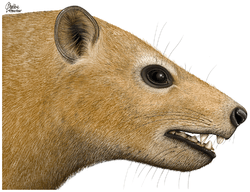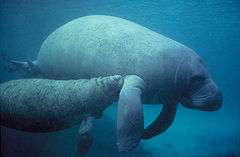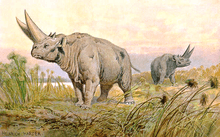Paenungulata
Paenungulata is a clade that groups three extant mammal orders: Proboscidea (including elephants), Sirenia (sea cows, including dugongs and manatees), and Hyracoidea (hyraxes). At least two more orders are known only as fossils, namely Embrithopoda and Desmostylia (desmostylians, however, have been placed in Perissodactyla by a 2014 cladistic analysis[2]). Each of these extinct orders was as unique in its members' ways as the surviving orders. Embrithopods were rhinoceros-like herbivorous mammals with plantigrade feet, and desmostylians were hippopotamus-like amphibious animals. Their walking posture and diet have been the subject of speculation, but tooth wear indicates that desmostylians browsed on terrestrial plants and had a posture similar to other large hoofed mammals.[3]
Of the five orders, hyraxes are the most basal, followed by embrithopods; the remaining orders (sirenians, desmostylians and elephants) are more closely interrelated. These latter three are grouped as the Tethytheria, because it is believed that their common ancestors lived on the shores of the prehistoric Tethys Sea; however, recent myoglobin studies indicate that even Hyracoidea had an aquatic ancestor.[4] Although morphological evidence continues to support the position of paenungulates with the ungulates, the molecular evidence suggests that Paenungulata is part of the cohort Afrotheria, an ancient assemblage of mainly African mammals of great diversity. The other members of this cohort are the orders Afrosoricida (tenrecs and golden moles), Macroscelidea (elephant shrews) and Tubulidentata (aardvarks).[3]
History
In 1945, George Gaylord Simpson, using traditional taxonomic techniques, succeeded in grouping these spectacularly diverse mammals in the superorder he named Paenungulata ("almost ungulates"). But there were many loose threads in unravelling their genealogy.[5] For example, hyraxes in his Paenungulata had some characteristics suggesting they might be connected to the odd-toed ungulates (Perissodactyla, such as horses and rhinos). Indeed, early taxonomists placed the Hyracoidea closest to the rhinoceroses, because of their dentition, and even some recent evidence suggested a possible affinity of Hyracoidea to Perissodactyla rather than to the rest of the Paenungulata. If true, this would mean that paenungulates are not a clade.
Later, genetic techniques were developed for inspecting amino acid differences among haemoglobin sequences. The most parsimonious cladograms depicted Simpson's Paenungulata as an authentic clade and as one of the first groups to diversify from the basal placental mammals (Eutheria). The amino acid sequences do not support a connection with perissodactyls (odd-toed ungulates).[5]
Gallery
See also
Sources
- Kleinschmidt, Traute; Czelusniak, John; Goodman, Morris; Braunitzer, Gerhard (1986). "Paenungulata: A Comparison of the Hemoglobin Sequences from Elephant, Hyrax, and Manatee" (PDF). Mol. Biol. Evol. 3 (5): 427–435. PMID 3444412. Retrieved 2010-07-24.
- McKenna, M. C., and S. K. Bell (editors). 1997. Classification of Mammals Above the Species Level. New York: Columbia University Press. ISBN 0-231-11013-8
- Seiffert, Erik; Guillon, JM (2007). "A new estimate of afrotherian phylogeny based on simultaneous analysis of genomic, morphological, and fossil evidence". BMC Evolutionary Biology. 7: 13. doi:10.1186/1471-2148-7-224. PMC 2248600
 . PMID 17999766. (pdf version)
. PMID 17999766. (pdf version)
- Simpson, G. G. 1945. "The principles of classification and a classification of mammals", in Bulletin of the American Museum of Natural History 85:1-350. (pdf version)
References
- ↑ Gheerbrant, Emmanuel; Filippo, Andrea; Schmitt, Arnaud (2016). "Convergence of Afrotherian and Laurasiatherian Ungulate-Like Mammals: First Morphological Evidence from the Paleocene of Morocco". PLoS ONE. 11 (7): e0157556. doi:10.1371/journal.pone.0157556.
- ↑ Cooper, L. N.; Seiffert, E. R.; Clementz, M.; Madar, S. I.; Bajpai, S.; Hussain, S. T.; Thewissen, J. G. M. (2014-10-08). "Anthracobunids from the Middle Eocene of India and Pakistan Are Stem Perissodactyls". PLoS ONE. 9 (10): e109232. doi:10.1371/journal.pone.0109232. PMC 4189980
 . PMID 25295875.
. PMID 25295875. - 1 2 Kleinschmidt, Traute; Czelusniak, John; Goodman, Morris; Braunitzer, Gerhard (1986). "Paenungulata: A Comparison of the Hemoglobin Sequences from Elephant, Hyrax, and Manatee" (PDF). Mol. Biol. Evol. 3 (5): 427–435. PMID 3444412. Retrieved 2010-07-24.
- ↑ One Protein Shows Elephants and Moles Had Aquatic Ancestors
- 1 2 Seiffert, Erik; Guillon, JM (2007). "A new estimate of afrotherian phylogeny based on simultaneous analysis of genomic, morphological, and fossil evidence". BMC Evolutionary Biology. 7: 13. doi:10.1186/1471-2148-7-224. PMC 2248600
 . PMID 17999766. (pdf version)
. PMID 17999766. (pdf version)
Further reading
External links

 . PMID 17999766. (pdf version)
. PMID 17999766. (pdf version) . PMID 25295875.
. PMID 25295875. . PMID 17999766. (pdf version)
. PMID 17999766. (pdf version)




